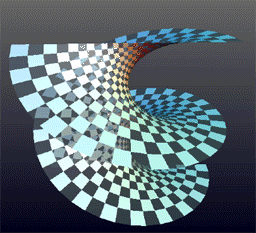Sketch proof
Following Do Carmo [4] we can express the second derivative of a parametrisation of a surface, in terms of the first fundamental form, second fundamental form and Christoffel symbols, then find equations linking the Christoffel symbols to the coefficients of the first fundamental form and their derivatives, showing that these are Christoffel symbols are invariant under isometries. Finally, an equation linking Gaussian curvature to Christoffel symbols shows that it is also invariant under isometries.
Let  be regular surfaces, and let
be regular surfaces, and let  be a parametrisation of a patch of the surface
be a parametrisation of a patch of the surface  , with unit normal
, with unit normal  . Denote the first derivatives of
. Denote the first derivatives of  with respect to
with respect to  and
and  by
by  and
and  and the second derivatives by
and the second derivatives by  . (As our surface is regular,
. (As our surface is regular,  .)
.)
Definition:
A diffeomorphism  is an isometry if for all
is an isometry if for all  and all pairs
and all pairs  the tangent space to
the tangent space to  we have
we have  In other words, the differential map between tangent spaces,
In other words, the differential map between tangent spaces,  preserves the inner product.
preserves the inner product.
This definition of isometry applies to the whole surface, for the theorem we only need a weaker definition, defined for small neighbourhoods.
Definition:
A map  of a neighbourhood of
of a neighbourhood of  of
of  is a local isometry if there a neighbourhood
is a local isometry if there a neighbourhood  of
of  such that
such that  is an isometry.
is an isometry.
If there exists local isometries for each  then
then  and
and  are said to be locally isometric.
are said to be locally isometric.
An immediate consequence is if  is a parametrisation of
is a parametrisation of  and
and  is a parametrisation of
is a parametrisation of  then the coefficients of the first fundamental form for both surfaces agree:
then the coefficients of the first fundamental form for both surfaces agree:  Furthermore, as
Furthermore, as  for all point
for all point  in the parameter space the derivatives are equal
in the parameter space the derivatives are equal  , etc., as are all higher derivatives.
, etc., as are all higher derivatives.
Now consider the second derivatives of a parametrisation  , these can be expressed in terms of the basis
, these can be expressed in terms of the basis  and Christoffel symbols
and Christoffel symbols  ,
,
 | | 1 |
Taking the dot product of each equation with  shows that the coefficients
shows that the coefficients  are the coefficients of the second fundamental form,
are the coefficients of the second fundamental form,  .
.
Let  be the coefficients of the first fundamental form
be the coefficients of the first fundamental form  ,
,  ,
,  . Their derivatives with respect to
. Their derivatives with respect to  are
are  Now take dot products of the second derivatives of the surface with
Now take dot products of the second derivatives of the surface with  and
and  to obtain expressions for the Christoffel symbols.
to obtain expressions for the Christoffel symbols.  Each pair of equations can be written as a matrix, for the first two
Each pair of equations can be written as a matrix, for the first two  and for non-singular surfaces the matrix is invertible with determinant
and for non-singular surfaces the matrix is invertible with determinant  , showing the Christoffel symbols can be expressed in terms of the coefficient of first fundamental form and their derivatives. This is a key result showing all geometric concepts and properties expressed in terms of the Christoffel symmetries are invariant under local isometries. We now show the Gaussian curvature can be expressed in this way.
, showing the Christoffel symbols can be expressed in terms of the coefficient of first fundamental form and their derivatives. This is a key result showing all geometric concepts and properties expressed in terms of the Christoffel symmetries are invariant under local isometries. We now show the Gaussian curvature can be expressed in this way.
The derivatives of the unit normal can be written as  and equations for these coefficients can be expressed in terms of the coefficient of the first and second fundamental forms, [5]
and equations for these coefficients can be expressed in terms of the coefficient of the first and second fundamental forms, [5] 
The third derivatives of our parameterisation  can be expressed as either
can be expressed as either  or
or  differentiating the two equations for 1 and equating these gives
differentiating the two equations for 1 and equating these gives 
Substitution in expressions from 1 and equating coefficients of  gives
gives  Rearranging gives
Rearranging gives  Giving the required expression for the Gaussian Curvature
Giving the required expression for the Gaussian Curvature  in terms of coefficients of the first fundamental form and its derivatives, so it is invariant by local isometries.
in terms of coefficients of the first fundamental form and its derivatives, so it is invariant by local isometries.
























































